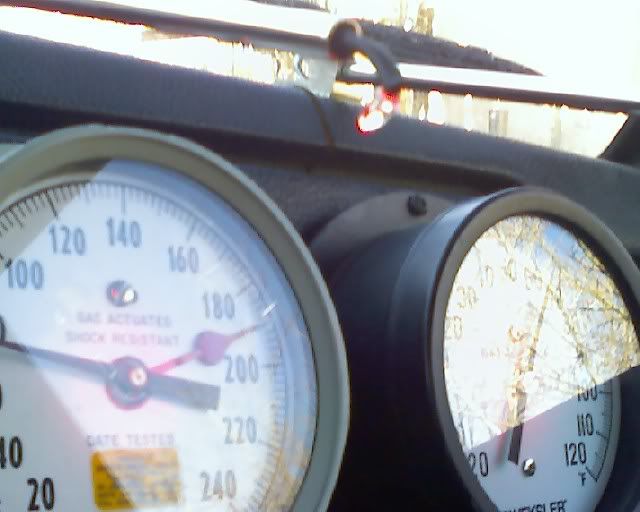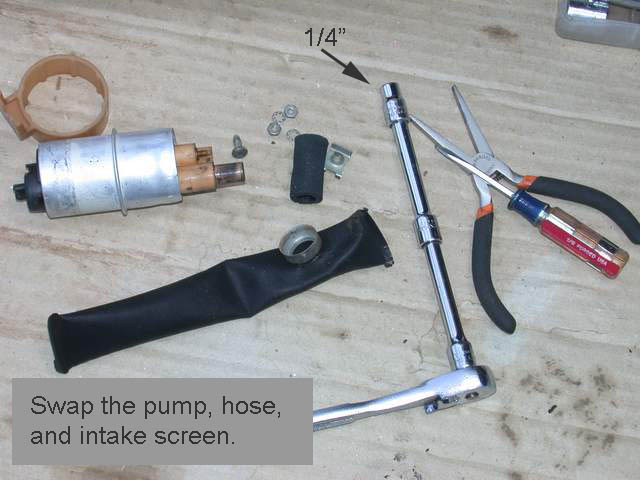|
|
|
On my 1980 242 I have recently replaced the In-tank fuel pump.I have just recently bought this car, and do not know any history, except that it sat-up for "around 2 years". When I removed the cover plate to access the top of the tank, the larger hose was connected to the larger out-put fitting on top of the sending unit, and that's all that was connected. There are two other outlet fittings, one being the return fitting, that extends down to the bottom of the sending unit, and another fitting that just enters and stops under the top plate. There was a 1/4 tubing line laying nearby which came from the back side of the accumilator, next to the main pump, and I connected that to the return line fitting, leaving the ouher fitting line alone. Latter,I saw another tubing line laying off to the side with a larger piece of rubber hose ,hose-clamped to the end of it with a bolt incerted to the other side of the added tubing on the end. My question is , of the three outlet fittings on top of the sending unit , what hoses go where. I know I have the main out-put line correct, but the other I not sure of.Thanks in advance, Joe
|
|

|
|
Hello,
If fuel is leaking past the fuel accumulator diaphragm, replace it.
The return hose can be fitted by carefully cutting the nylon tube away from the fittings and installing rubber fuel line with clamps. The third small connector is a vent, and on my car I connected it to the Evap System.
Goatman
|
|
|
|
|
Goatman, Thanks for the reply. But I'm still confused. There was No fuel comming out of the tubing from the back of the accumilator. I connected that line to the return fitting at the top of the sending unit. Is the other line that is blanked-off wih a bolt in it , is that my return line?, and should that be connected? Joe
|
|

|
|
The three fittings are as such:
1. 12mm outlet to main pump inlet.
2. 8mm fuel return from fuel distributor.
3. 5.5mm from fuel accumulator.
The #3 line is often found tied off with a bolt stuck in it at the accumulator end once the accumulator got updated to the sort with no diaphragm vent. Later cars have a cap on this nipple.
Evap is done at the fuel filler pipe, not at the tank bung.
In The Tank
--
Art Benstein near Baltimore
After attending an opera, Yogi mentioned that he liked it, and added, "Even the music was nice."
|
|

|
|
Art,
Yes, I understand that the port is capped on later models. Unfortunate, due to the inferior quality of Autozone parts, it was easier to connect a hose and port it into my evap system.
Do you have the Volvo part number for the cap?
Goatman
|
|

|
|
Kyle,
No, I don't have the part number for the nipple cap. I would not think of going to Volvo for that part. Going by the looks of the Volvo-supplied parts, after a couple decades have passed, it is hard to believe they'd be any better than a new one from the Help bubble packs at Autozone.
I've been in an Autozone before, although it is quite a drive from here. Are all their parts equally inferior, and if so, inferior to whose?

--
Art Benstein near Baltimore
The trooper started to lecture the cowboy about his speeding, and in general began to throw his weight around to try to make the cowboy feel uncomfortable...
|
|

|
|
Art,
I've resorted to masking tape, on several vacuum line connections, and a cork stopper in a vacuum tee. Not a quality fix whatsovever, but after replacing those help vacuum caps every month, I feel my fix is superior.
Goatman
|
|

|
|
I've resorted to masking tape, on several vacuum line connections, and a cork stopper in a vacuum tee. Not a quality fix whatsovever, but after replacing those help vacuum caps every month, I feel my fix is superior.
Really? I know we're talking fuel and not vacuum, and suspect some fittings made for vacuum lines might not stand up to the alcohol in the fuel these days, but, "replacing vacuum caps every month??"
The image I get from your posts is your 264 isn't even driven every month, but I admit the view is somewhat myopic from here.
Still curious about your inferior statement. The superiority of your fixes is unquestionable.
--
Art Benstein near Baltimore
Finally, the trooper got around to writing out the ticket. As he was doing that, he kept swatting at some flies that were buzzing around his head. The cowboy said, "Y'all havin' some problem with circle flies?" ...
|
|

|
|
Boxy,
Yeah, the accumulator does not need to be connected to anything.
Make sure that the return line is connected!!!
Also, try starting fluid in the air filter to help start the engine.
Goatman
|
|
|
|
|
Thank you Very much to Goatman, and Art. My 1980 242 is Running. I connected the return line(which was found plugged with a bolt and hose clamp),to the return fitting at the top of the sending unit. Then gave a shot of starting fluid in the air intake, as suggested, and WOW. It started and ran , smoothed out and sounds pretty good.I could see when I went to change the in-tank pump, that there was a recently installed New gas tank on the car, the bottom is under-coated, but the top half is bright silver colored galvanize. With a couple of fasterner bolts not installed. So, someone had been there ,not knowing what there doing. I've been poking around with this car since the begining of August. Take a look at Bric Pix dated Aug. 10th for a picture of my now runing 242. Thanks to Everyone for your time and advise. Joe
|
|

|
|
"I connected the return line(which was found plugged with a bolt and hose clamp),"
That plugged return line (what were they thinking?) caused fuel pressures to go sky high. So the airflow plate was effectively "locked" down by the high pressure on the control plunger -- and thus no fuel to the injectors.
I guess my reply in your Oct 10th post HERE was too long to catch your full attention, but I suggested something that might have pointed you to this problem saying: "(b)...upward resistance would be felt immediately, with no plate movement possible at all. Full System pressure on the plunger will lock it down solid."
I only bring this up now in the hope that you or any readers planning to maintain a K-jet car will consider a Fuel Pressure test as "Step 1" in trouble-shooting. Although this does require a special gauge setup with two connecting hoses and a valve to select between them, the K-Jet (aka CIS) gauge can be found at a good price at J C Whitney.***
***EDIT: Sorry, it looks like JCW doesn't have that gauge any more. They may be getting scarce now. Try eBay for K-Jet or CIS Fuel Pressure Gauge.
--
Bruce Young, '93 940-NA (current), 240s (one V8), 140s, 122s, since '63.
|
|
|
|
|




